 |
Knox County--1869 |
This is a NEGenWeb Project web page
and is presented as part of the
MARDOS Memorial Library Collection.
Knox County--1869
|
Of the Czech pioneers in Nebraska, those in Knox County struggled with greatest difficulties. All the others had settled, in the early days, in central or southeastern counties, already inhabited by whites, but Knox County was then on the edge of civilization. It was a bit of the old "wild west", with plenty of Indians, trappers, traders and now and then cowboys. The Ponca and Santee-Dakota Indians had massacred white settlers in Minnesota in 1862 and had been moved to Knox County in 1865. The Dakota-Sioux Indians had their reservation about 150 miles west, in what is generally known as the Rosebud Country. They were enemies of the former, upon whom they swooped at intervals. Similar conditions were hard enough to bear by English-speaking settlers, native Americans, who naturally had more grit and self-assurance than new-comers from a foreign land, unable to speak the language. Our people paid not only the common toll in hard work and privation, but in human lives also. The murder of the two Brabenec children, and death by prairie fire, as recorded herein, are examples of what they had to undergo in addition to drouths, blizzards, grasshopper plagues and other catastrophes. Aside from that, the country did not have a railroad for many years, much longer than was the case in many other pioneer communities of eastern Nebraska. 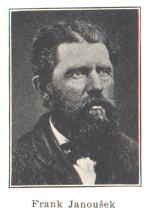
In 1868 a Czech colonization club "Ceska Osada" (Czech Colony) was founded in Chicago. It had over 500 members there and branches in Cleveland, Detroit, Milwaukee and other cities. Its object was to find suitable locations for Czech immigrants. After a committee had investigated several locations in Kansas, Minnesota and northwestern Nebraska, Frank Bem and Frank Janousek (born in Sadska, near Prague, Bohemia, 1812, died in Niobrara, 1886) reported favorably for the Niobrara Valley in what is now Knox County. The first expedition of settlers, under the leadership of Bem and Janousek, arrived in Niobrara in July, 1869. It consisted of Frank Nedved, Joseph Pechan and family, Carl Schindler, Daniel Cap, Thaddeus Pisek (father of Mrs. John F. Lenger) and his nephew John, Alois Chladek, Cyril Jandus, Joseph Hrdlicka, Frank Fejfar and daughter. They were not favorably impressed (with the exception of Schindler) and went to Dakota, near Yankton, then the territory capital. An engineer from there, Charles Meyers, had told them about lands in that part of the country. Bem stayed in Yankton, but Janousek remained in Niobrara, as did Schindler. In October of that year a second expedition left Chicago, consisting of Joseph Sedivy (born in Nymburk, Nov. 28, 1825, died March 12, 1912, in Marmora, Va.) and family, John Holecek (Bobnice near Nymburk, 1826, died on his homestead near Niobrara Jan. 27, 1911) and family, Joseph Krupicka (Libice, near Podebrady) and family, Joseph Gregor and wife (Bohemian Germans), Frank Vampula and wife and Joseph Noll and wife. 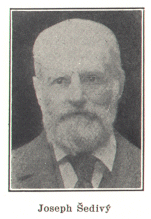
They travelled by rail as far as Sioux City, then a town of 1,000 inhabitants, a terminal railroad point. Thence by wagon one hundred miles further to their destination. They had expected to go by boat, but the season was advanced and river transportation closed until spring. Joseph Sedivy, who had owned a grocery store in Chicago, was somewhat wealthier than the rest. He had enough money to buy a yoke of large oxen, a new Schuettler wagon, and a load of provisions. Noll and Vampula together had bought a new wagon in Chicago and a yoke of young oxen in Sioux City. Holecek and Gregor had worked in Chicago, where part of their wages had been held back, the former $90.00, and Gregor $70.00. They empowered a Czech lawyer, Frank Partl, to collect the money, but each received for his share only $25.00, and that was all the capital they had to begin with. Holecek had also brought some provisions. After the necessary expenses had been paid, each had only $10.00 left. Vaclav Randa, who came later, was accounted the richest man in the colony. He possessed $400.00. 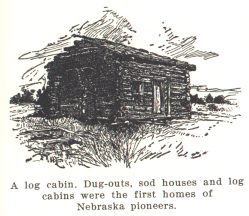
Their way lay over a barren, burned-over prairie, with no sign of habitation or living thing. Soup made from prairie chicken was the first native meal they enjoyed. They were led by Sedivy, Krupicka acting as his driver. Both men had left their families in Sioux City, until a later time, and they arrived in Niobrara on Nov. 2, 1869. The women and Holecek's son, Joseph V. (of whom mention is made elsewhere), walked all the way, the men being occupied with the oxen. Niobrara at that time consisted of a log store belonging to Westerman & Bruns, traders; a frame house belonging to Tom N. Paxton; a house in which Janousek was living, and a log cabin near the river, the home of C. G. Brenner and family,--beside about twenty Indian tepees. It was truly an Indian village, in name and in inhabitants. This group of colonists suffered quite a loss. They had been advised by Janousek and Bem to take along furniture and supplies, the country being devoid of settlements. Upon their arrival in Sioux City they had placed their household goods, clothing, provisions, etc., in storage with Charles and Tuttle. The day after Sedivy left with the expedition, a company of soldiers, recruits, bound for Fort Sully, Dakota Territory, was quartered in the same warehouse. In a drunken state they broke into the boxes, stole and sold or destroyed the contents. Sedivy suffered a loss amounting to $246.50, the others a total of $239.00. The police was unable to cope with the situation and a lawsuit, instituted by Sedivy, was of no avail. The two families that had been left behind followed on November 18, 1869, arriving in Yankton on November 21st. They lived there in an abandoned farm house, waiting for the river to freeze, so they could get across. On December 17, 1869, they arrived at their destination. Sedivy's entire fortune in cash at that time consisted of $5.00. 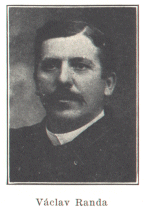
The following spring (1870) brought another group, led by Vaclav Randa (born in Domazlice, Bohemia, March 15, 1843, died in an Omaha hospital in 1900, buried in Niobrara, a prominent politician and officeholder) and a Chicago lawyer named Frank Partl. They were accompanied by the families of Frank Tichy (born in Jankov, Votice), Frank Vokner (born in Chvalkovice near Caslav, 1837), John Hajek, (born 1834, died 1924), John Schreier (born in Sipy near Kralovice, 1827), Thomas Brabenec, John Prasek, Matej Hrbek (born in Podhori, Milevsko), Joseph Tikalsky (born in Hrdlorezy, near Trebon), John Tikalsky (born in Suchdol, near Trebon in 1848) and others. For Brabenec and his wife a tragedy was waiting, the murder of their two children. With the rest they had set out from Sioux City on March 25th, 1870, by oxen-drawn wagons. They did not know how to guide their teams in American fashion, so made slow progress and at last were obliged to leave the heavier load behind, taking only clothing, featherbeds and food. It began to rain and after two days' delay they started out against the advice of their hosts, German farmers. Before they had gone any distance, the rain turned to snow, the oxen sank into the mire and could not proceed. What now? How best to spend the night under the open sky? The bread was frozen, so they cut or bit off morsels with great difficulty. The men ran about to keep warm, while the women and children crept under the featherbeds, to keep from freezing. So, on the open prairie, as in other instances in dug-outs, during blizzards, the good old Bohemian featherbed was a boon and salvation.
As they proceeded, the weather became milder and finally they reached Niobrara. Brabenec, Hrbek and Prasek took adjoining claims, on the third bottom of the Niobrara River Valley. The men immediately began to fell cottonwoods and the first dug-out, for Brabenec, was finished by noon. Then they continued, hoping to make for the other two a shelter at least. Mrs. Brabenec, as was to be expected, baked bread the first thing. She was kneeling by the oven door, to see how it was coming on, when the entrance was darkened by several Sioux-Dakota Indians, the inveterate enemies of the Poncas. The frightened woman glanced up and one of the savages held out his hand with the word "How". She thrust it aside and uttered a Czech exclamation of disgust. The Indian, probably insulted, shot her in the thigh, but did not wound her seriously. In the meantime, the men were busy in the grove nearby. They heard shots coming from the direction of Brabenec's claim and hurrying thither, found the wounded woman. Carrying her out, they resuscitated her and then searched for the children, fourteen-year-old Caroline and twelve-year-old Johnny. The boy was found shot to death in the tall grass, the girl they could not find. All three families, thoroughly alarmed, started for Niobrara. When they had gone about half way, they were confronted by Ponca Indians, who assured them of protection, so they took refuge in Carl Schindler 's home. After several days they repaired to the place where the tragedy had occurred. As they approached the Brabenec claim, a dreadful odor met them from the wild choke-cherry thicket and bushes. It came from the decaying body of Caroline. Mr. and Mrs. Brabenec had no other children and after a very few years they returned to Bohemia, to try to forget their sorrow amid other scenes. As far as has been recorded, this is the only instance of Czechs being killed by Indians in Nebraska. For several years, until 1879, the settlers were in constant fear of the redmen. In April, 1871, they were invited to assemble for a neighborly council in Carl Schindler's home, for the purpose of planning how best to stop their depredations. They decided to build a log fort and asked the commander of Fort Randall to place soldiers in it, which he did, giving them fifteen men for protection. In those days Indian graves, placed high up in the trees, were a common sight. The bodies, encased in wrappings of skin, were fastened amid the branches and left there to the elements. They all vanished in succeeding prairie fires, so dreaded by pioneers. In 1879 two Czech lives were thus sacrificed. Mrs. Marie Dvorak, fifty years old, and her fourteen-year-old son perished in the flames. 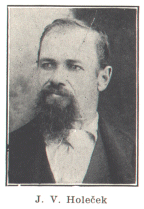
The foregoing has been taken from Jos. V. Holecek's account of the settling of Knox County by Czechs, published in the almanac Amerikan in 1922 and from what Jos. P Sedivy (son of Joseph Sedivy) wrote in various articles for Czechs, published in the almanac Pionyr. Both men came as boys with their parents with the first expedition that settled in Niobrara. Joseph V. Holecek was born in Cerna Hura near Dymokury, in August, 1856, and is living in Niobrara. Joseph P. Sedivy was born in Nymburk, October 28, 1856, died in Verdigre, Nebr., December 13, 1918. His father, Joseph Sedivy, kept a diary, from which the following is taken: "When I arrived in Niobrara, there were six settlers there. The county surveyor (the first, elected in 1870) was a squaw man, his wife being a Ponca Indian, and this was true of some other white settlers, mostly Frenchmen. A squaw man named Wall lived in a log house. That and a few Indian tepees constituted Niobrara. The law, as far as the county was concerned, was administered in various places, there being no court house. Henry Sturgess, the second county clerk, had an office in his home, a mile west of Niobrara. H. Westerman, county treasurer, officiated in his log store and for the year 1870 he collected $70.00. There were hardly any settlers, who was to pay taxes? T. N. Paxton, county judge, occasionally performed the marriage service for Indians. In those days the land office was in Dakota City a distance of 110 miles, which I had to traverse twice, that is,--make two trips, to arrange for entry on land. I had helped some of the others with expenses, but few could repay me in cash, although they did repay me in work. Thus, although I had been in fair circumstances, I became so poor that I had not five dollars with which to buy a sack of flour. The first year (1870) was dry, the second brought hail, the third grasshoppers. We asked help from the commander of Fort Randall, where we went a distance of forty-five miles. We told him that his soldiers had robbed us in Sioux City, but while he could do nothing about that, he had two spans of mules harnessed to a wagon and sent us sixty bushels of corn, four barrels of flour and four boxes of dried soup. There were fifteen families of us at the time, it was meant for all. 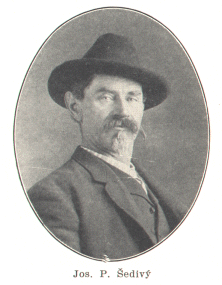
During the next three years none of the settlers except Janousek, Randa and me had teams. We three had oxen. I loaned mine out to those who had none and they repaid me by work of their hands. I used to haul flour from Norfolk, the nearest mill, seventy miles away. No roads, no bridges, no farms, no timber--all the way over those seventy miles not a fragment of wood to be seen. I had to take along an ax, hoe, shovel, fuel and provisions, that I could cook food, and I used to sleep under the wagon, wrapped in a quilt. How did I know the way to Norfolk? My land was crossed by Texas cattle trails, which the cowboys used when driving the animals to reservations and military forts. They did much damage and when I remonstrated, a cowboy aimed his revolver at me and told me if I did not like it, he would make it plainer. Once when I was bringing twenty sacks (100 pounds each) of flour from Norfolk and was fording the stream, my wagon broke through the ice. I had to unyoke the oxen, pick out the broken ice between the wheels, pull out the empty wagon, and re-load. I was so drenched and frozen that I had to run to the nearest farm, owned by a German, who gave me clothing while mine was being dried. A few years later a mill was built in St. James, fifty miles distant, where we then went, but the way was hilly and in winter our oxen suffered greatly on the ice-covered roads. At the mill there was no shelter. We had to tie the beasts to the fence and in the morning found them covered with snow. We ourselves had to spend the night on the bare floor in the mill. The Niobrara river was and is full of quicksand and is hard to ford. We Czechs were always on good terms with the Ponca Indians, although we had to put up with their thievery, until we complained to the commander of Ft. Randall, who stopped it. However, I remember a tragedy of one of my neighbors, a Frenchman. His Indian wife and mother of his four children died, whereupon he took a new spouse, a young Indian girl. The following day two bucks appeared and wanted her back. He would not give her up and they beat him to death with clubs. These French squaw men got supplies from the government the same as if they had been Indians." Joseph Sedivy was the first Czech to pay an entry fee on a homestead in Knox County and for some time the only one to own a team of horses. Those were cowboy days, when herds numbering thousands of animals were driven north to the forts and reservations. Janousek had a saloon in Niobrara. What more natural then that the cowboys should ride up to the bar and demand a drink, or offer the alternative of shooting up the place? However, Janousek was a diplomat. Quietly, and sometimes very hurriedly, he made his exit when they began to shoot, and sent his wife in his stead. Even drunken cowboys respected a decent woman and subsided, departing without causing much damage. Drouths, grasshoppers, Indians, privations--all of this our people had to endure. In times of poor harvests the commander of Fort Randall gave them provisions for sustenance. In negotiating for these Anton Pishel (Pisl, born in Rychnov, 1836, died in Santa Rosa, Cal., Feb. 1, 1900) who was tailor in Fort Randall, was of great assistance, for he was about the only man who could speak some English. He and his son also spoke German fluently. Thus he laid the case before the commander in full and was not refused. The postoffice Pishelville was named for Mr. Pishel. Like many other small postoffice stations, it was abolished after the rural mail delivery was instituted. Emil Pishel (the son), who conducted the store established there by his father, sold it and lives in retirement on his farm. The winter of 1880-1881 was a cruel one, with heavy snow. The nearest railroad, the Chicago, Milwaukee and St. Paul at Running Water, South Dakota, over the Missouri River, had no trains running. The Niobrara Pioneer, a weekly, was printed on wrapping paper used in the store of Bonesteel & Company. In March a thaw came on, the ice broke and the town was inundated. The inhabitants were obliged to change to a higher location, so they moved the entire town a mile west and old Niobrara became a pasture. During the summer and fall of 1870 Verdigre valley was a waste. The only Czech settlers there were Joseph Mlady and John Tikalsky, whose homesteads later became the site of the town of Verdigre. Mlady was born in Skrychov, Milevsko. Tikalsky was born May 15, 1848 in Suchodol near Budejovice and came to Chicago July 1, 1867. In April, 1870, he took 160 acres in Section 5. Living at the age of 78 with his son Ben, on a farm near Verdigre. Later the Following Settled There: 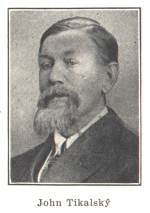
Matej Pavlik and his sons. Joseph and John, born in Bozetice, Tabor; V. Stoural, Stare Prachatice, Pisek; Frank Pavelka, Stare Prachatice, Pisek. (Came from Minnesota). John Beran, Bozetice, Tabor. Came from Chicago. Died in 1925. Joseph Dryak, Luzec. Born 1842, came to Chicago in 1866. In 1870 he took 320 acres in Sec. 31, T. 32, R. 7, near Pishelville. Lived there 48 years, died in 1921. Joseph Pavlik, son of Matej, born in Bozetice near Tabor, Sept. 16, 1847, come to Chicago in 1867. In 1870 took 160 acres in Sec. 4, adjoining the town of Verdigre. Still living. John Bartak, Sestroun near Tabor, born Dec. 26, 1840. Came to Chicago in 1867. In 1880 took up 160 acres west of Verdigre. Died May 12, 1922. Joseph Kalal, Podhori, Tabor; Frank Kalal, his father, with two sons; John Vagac (Vakoc), Sepekov, Milevsko; Vaclav Jedlicka, Podoli, Pisek; John Ondracek, Bozetice, Tabor; Vaclav Dusek, Bozetice, Tabor; Joseph Souhrada, unknown; Vaclav Tomek, Pisek, Lhota; Frank Havlicek, unknown; Mikulas Kocina, unknown; Vaclav Mrzena, Bozetice, Tabor; Matej Markytan, unknown. Mrs. Anna Kalal, widow of Joseph Kalal, writes: 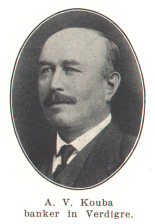
"On September 15, 1873, we started out by rail from Chicago via Sioux City, Iowa, to Yankton, South Dakota, the terminal point. With us, beside my husband, our son, eleven months old, and me, travelled my husband's father, Frank Kalal, with his two sons, John Vagac with two children and Vaclav Jedlicka with his wife, who was a sister to my husband. From Yankton we went by wagon to the Missouri River, on the other side of which was situated the little town of Niobrara. We were ferried across. My cousin Joseph Mlady was, with John Tikalsky, the first settler in Verdigre valley and we were going to him. My husband and John Vagac set out afoot to his farm, to arrange for a vehicle for us. In the meantime I tried to purchase provisions, but could not find anything except very poor white bread. Not even potatoes, which I wanted to bake. The only store in the place belonged to Mr. Westerman. We tried to stay our hunger as well as we could with the sour bread and slept on the river bank. The next day (September 28th) the vehicle, with oxen, arrived. Each set his trunk inside and sat down on it. I soon saw that I could travel faster afoot, so I got out and went ahead with my child on my arm. I reached Mr. Hajek's farm, he had been living there two years. I was then only nineteen years old and although exhausted by fatigue and hunger, I still had to feed my baby. On the way I often met Indians but was not frightened, for my father, an old soldier, had taught his children to be brave and unafraid. I rested at Hajeks and then continued until I got to Frank Pavelka's farm, where Joseph Pavlik and John Mastalir were building a log house. I asked for water, but all they could offer me was water from the stream. Seeing that Mrs. Pavelka had cottage cheese cooking on the stove, I asked for the whey and refreshed myself with that. Mrs. Pavelka prepared lunch consisting of coffee made of parched rye, corn bread and squash. Feeling strengthened by it, I set out again and had to ford a brook. Upon reaching the farm of Joseph Mlady, my cousin, he was much surprised to think I could have walked thirteen miles, with the baby in my arms, and hungry most of the time. The rest arrived three hours later. In Mlady's home was also the family of Vojtech Stoural and Frank Maly, stepson of Mlady. We newcomers numbered four families more and Mlady's had but one room, 20x20. So I went to their daughter, Veronica, Mrs. John Beran, who lived two miles further. My husband felt like going back to Chicago immediately, but I urged him to have patience. We brought with us $500.00, which was a small fortune in those times. For instance, the family of Joseph Mastalir, who brought but a few dollars, suffered much privation. They could not buy a cow or a team for a long time. We used to give them milk and my husband plowed for them, they paying back in work. All of those first homesteaders endured bitter times. During the first year we had five acres of corn but the grasshoppers destroyed it in one hour. The next year was promising, in June we had fine cucumbers and peas. June 26th hail fell so heavily that three days later it still lay in the gullies. My husband departed for Chicago, to earn some money. John Beran and Frank Pavlik went to the vicinity of Yankton, to work in harvest, for there were a few older settlers there. When my husband was returning home, with his savings in his pocket, somebody stole the money on the train. He arrived with just five cents. One time, when he was away cutting slough grass to cover the roof of the shelter for stock, I was home alone. About twenty Indians came in asking for bread. I cut slices and spread them with syrup and they went away satisfied. I was never afraid of them; in fact, I found them reliable and friendly. After farming fifteen years we moved to the newly-established town of Verdigre where we conducted a meat market and hotel. Three children were born to us. One boy died at the age of five. My daughter, who married Dr. Clark, died at the age of 37. My oldest child, Dr. F. J. Kalal, who practiced for many years in Nebraska, is located in Texas. My husband died in 1926 and I live with my granddaughter." It was not until after 1880 that settlements in this vicinity began to form, mainly on account of lack of railroad transportation. At present Czechs live in and about Niobrara, Pishelville, Knoxville, Sparta, Jelen and Verdigre. |
| Back | Table of Contents | Next |